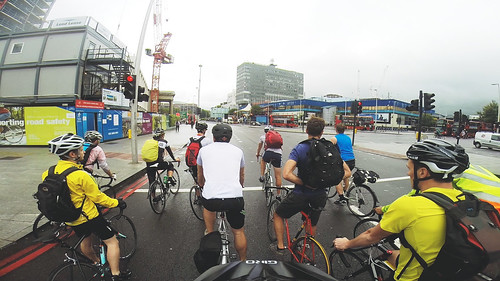Some of us are fortunate enough to cycle to and from work.
Of course, such an arrangement is not feasible for everyone. So, some people ride their bikes to another mode of transportation, such as a train or bus, that takes them to their jobs. It's been a while since I've been that type of commuter. But my memories of it are not fond, in part because I wasn't crazy about the jobs I was working--but, more important, the companies and agencies that operated the bus and train lines I used didn't make it easy.
Back when I was a multi-mode commuter, the stations I used (on the Long Island Rail Road and New Jersey Transit) had no provisions for cyclists. You found a pole or parking meter to which you locked your bike: pretty much the same ordeal you faced if you took a bus, as I did for a time when I was living in New Jersey.
Many train stations pose a further inconvenience to cyclists: If the train line happens to follow a street you want to cross, you have to take a detour if the tracks and platforms are at or near street level.
If someone had told me that, one day, my local station would be completely navigable by bicyle--yes, that you could pedal to the platforms or under them to go through the station--I would have wanted to inhale whatever that person was smoking. Even today, I'd wonder whether someone making such a prediction had taken his or her medications beforehand.
Well, it turns out there is such a station. The tracks and platforms are raised above the street level. Underneath them, at street level, a tunnel for cyclists and pedestrians passes through--and provides access to the platforms.
That station is--where else?--in the Netherlands.

This testament to good planning is in the Den Haag HS railway station, in the Hague. The tunnel runs between Waldorpstaat and Stationsplen/Parallelweg in the home of the UN's International Court of Justice.
I'd say the tunnel does plenty of justice to cyclists and pedestrians.
Of course, such an arrangement is not feasible for everyone. So, some people ride their bikes to another mode of transportation, such as a train or bus, that takes them to their jobs. It's been a while since I've been that type of commuter. But my memories of it are not fond, in part because I wasn't crazy about the jobs I was working--but, more important, the companies and agencies that operated the bus and train lines I used didn't make it easy.
Back when I was a multi-mode commuter, the stations I used (on the Long Island Rail Road and New Jersey Transit) had no provisions for cyclists. You found a pole or parking meter to which you locked your bike: pretty much the same ordeal you faced if you took a bus, as I did for a time when I was living in New Jersey.
Many train stations pose a further inconvenience to cyclists: If the train line happens to follow a street you want to cross, you have to take a detour if the tracks and platforms are at or near street level.
If someone had told me that, one day, my local station would be completely navigable by bicyle--yes, that you could pedal to the platforms or under them to go through the station--I would have wanted to inhale whatever that person was smoking. Even today, I'd wonder whether someone making such a prediction had taken his or her medications beforehand.
Well, it turns out there is such a station. The tracks and platforms are raised above the street level. Underneath them, at street level, a tunnel for cyclists and pedestrians passes through--and provides access to the platforms.
That station is--where else?--in the Netherlands.
This testament to good planning is in the Den Haag HS railway station, in the Hague. The tunnel runs between Waldorpstaat and Stationsplen/Parallelweg in the home of the UN's International Court of Justice.
I'd say the tunnel does plenty of justice to cyclists and pedestrians.
































